Video ad revenue has seen significant growth, with the worldwide video advertising market projected to grow by 41.1% from 2020 to 2027, resulting in a market volume of US$229.80 billion in 2027.
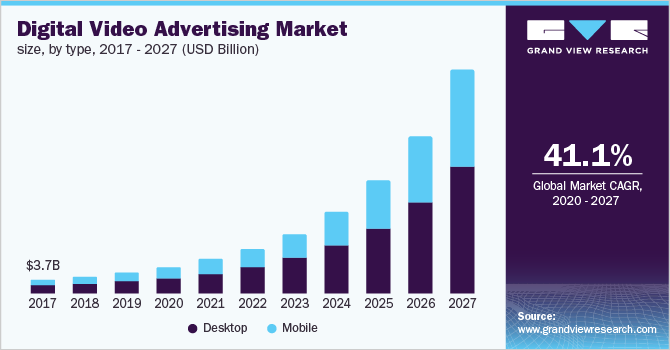
With so much growth, monetizing digital content through advertising products continues to be a fundamental revenue strategy for digital publishers.
Including video advertising provides revenue diversification while enhancing user engagement, as you'll see. Video ads have proven highly effective, as customers are more responsive to video content than text, and platforms like Twitter and Instagram have reported substantial video views and user engagement.
Understanding how to integrate video ads into your content effectively is crucial. You must balance monetization with user experience to retain and grow your audience. Successfully monetizing video content involves selecting the right platforms and ad formats that align with your publishing goals while providing value to advertisers. With a range of video ad products available, including pre-roll, mid-roll, and post-roll ads, you have the flexibility to choose what works best for your content and viewers.
But where do publishers start when navigating the complexities of video monetization?
Let's go back to the basics.
What Is Video Monetization With Ads?
If you're a digital publisher, understanding video monetization with ads is a path towards turning your video content into a revenue stream. At its core, video monetization refers to the process of generating income through your posted videos by including advertisements.
When you monetize your videos, you're essentially pairing them with ad inventory—slots that can be filled with promotional content from advertisers. These advertisers pay to showcase their ads, and in turn, you earn money as these ads are viewed or clicked by your audience.
The magic that brings these ads to your videos is a video ad server. This technology helps you manage and serve ads across your content. It ensures that the right ads reach the right audience at the right time, increasing the potential for click-throughs and, consequently, your earnings.
By considering the types of ads served, the frequency, and placement, you can create a monetization strategy that works best for your content and audience, ensuring everyone walks away satisfied.
Benefits of Video Ads
With the potential to spike your engagement rate and ad revenue, video ads are a key asset in your digital publishing toolkit. Let’s get into how video ads can make a substantial difference for you.
Better Engagement and Recall
Video ads are designed to capture your audience's attention more effectively than static ads.
According to a study by MediaMind, prospects are 27.4 times more likely to click through online video ads than standard banners, and almost 12 times more likely than rich media ads. Additionally, a user's positive experience with a video ad increases their purchase intent by 97% and brand association by 139%.
By integrating motion and sound, these ads can significantly boost your engagement rate. Viewers are likely to remember visual and auditory information better, leading to a stronger recall of your message.
Higher Revenue Opportunities
When you feature video ads, you can generally expect to see higher CPMs (Cost per Thousand Impressions). This translates to greater profits for you, the publisher. Numerous monetizing strategies are available that leverage video content, from direct sales to programmatic platforms, all promising amped-up revenue streams.
Gaining Viewer Attention
Securing your audience's focus in a busy digital landscape is challenging, but video ads are your secret weapon. A recent study that 84% of consumers have been compelled to buy a product or service after watching a video, and consumers are more than twice as likely to share video content compared to other types of content.
These ads are not just about selling; they're an opportunity to offer enriching user experience. A well-crafted video ad can turn a simple view into a memorable interaction, making it invaluable in the fight for your viewers’ attention.
How to Monetize Video With Ads
As a digital publisher, you can monetize your video content effectively by selecting the right ad formats, managing the quantity and pace of ads per user, and setting appropriate pricing. These key elements can help maximize your ad revenue while maintaining a positive user experience.
Ad Formats
When it comes to ad formats, your choices will directly influence your CPMs (cost per thousand impressions). Popular video ad formats include pre-roll, which plays before your content starts, mid-roll, which appears during video playback, and post-roll, which shows after the video ends. Additionally, overlay ads that appear on top of video content and companion ads that display alongside your video player can complement your monetization strategy. It's essential to choose ad formats that align with both user experience and revenue goals.
- Pre-roll Ads: Typically have higher engagement as they play before the content.
- Mid-roll Ads: Can be effective if well-placed within longer content.
- Overlays: Offer less intrusive advertising while content plays.
- Companion Ads: Maintain visibility even if the video is paused or skipped.
Ad Quantity
Ad density refers to the number of ads shown during a certain duration of video content. Having too many ads can be intrusive and lead to a poor viewing experience, while too few may underutilize your earning potential. Balancing ad density is crucial; you'll want to keep your audience engaged with the content without feeling bombarded by ads.
- Low Density: This may lead to a better user experience but lower ad revenue.
- High Density: Could increase earnings but risks higher viewer drop-off rates.
Ad Pricing
Setting price floors for your ads can help establish a minimum CPM rate, ensuring you're not underselling your ad space. Price floors protect the value of your inventory but set them too high, and advertisers might go elsewhere. It's a strategic decision that requires understanding the worth of your content and the current demand in the advertising market.
- Minimum CPM: This is the lowest rate you’ll accept for your ad space.
- Demand Assessment: Regularly assess market demand to adjust your price floors.
Your approach to these areas can significantly impact your overall ad revenue, and it's worth the effort to get them right. Remember, the most successful video monetization strategies are those that strike a balance between profitability and user experience.
Main Types of Video Ad Products
Digital publishers can monetize their video content in several ways. These video ad products help leverage your content and audience for revenue generation.
In-Stream Video Ads
In-stream video ads are akin to traditional TV commercials, inserted before, during, or after your video content. They are an effective way to monetize as they hold the viewer's attention within the content stream. Instream Video Advertising guidelines by the IAB are aimed at promising premium revenue for publishers.
Pre-Roll Ads
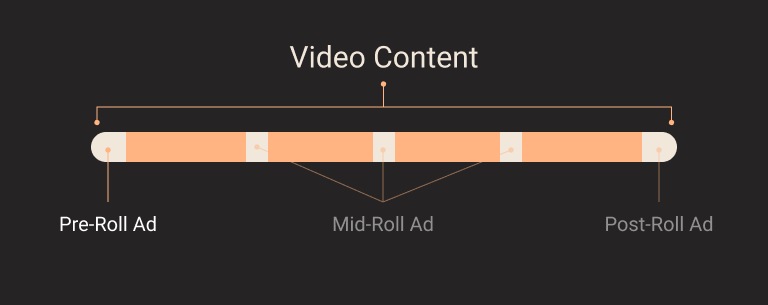
Pre-roll ads appear before your video content starts and are typically 15 to 30 seconds long. They offer a high visibility rate, making them advantageous for advertisers and beneficial for you as a publisher regarding ad revenue.
- Strengths: High visibility and engagement rates, as viewers are eager to consume the content that follows.
- Considerations: Keep them short (15-30 secs) and compelling to mitigate drop-offs.
Mid-Roll Ads
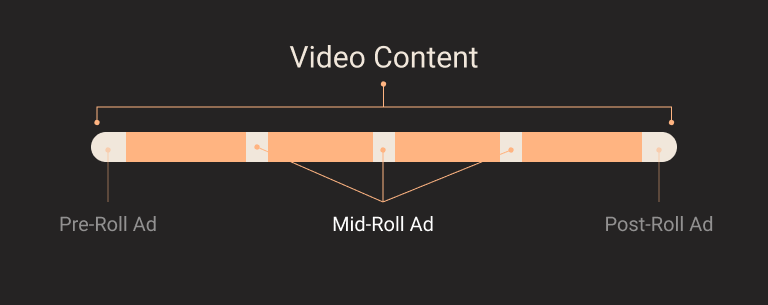
Mid-Roll Ads are advertisements that interrupt the video content at a midpoint. Because viewers are already engaged with the content, these ads can command higher prices and are less likely to be skipped, ensuring better ad performance.
- Strengths: Can maintain viewer engagement if placed at natural breakpoints in the content.
- Considerations: Risk of disrupting viewer immersion, challenging to keep the user for a full 8-10 minutes to reach a mid-roll ad format.
Post-Roll Ads
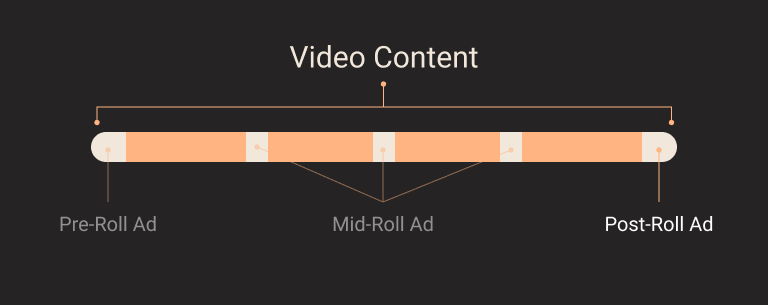
Post-roll ads are shown after the video has concluded. While they have lower visibility compared to pre-roll and mid-roll ads, they can still contribute to your revenue if the content is engaging enough to retain viewers until the end.
- Strengths: Opportunity for additional messaging to an engaged audience.
- Considerations: Lower engagement potential, as viewers may leave before the ad plays.
Pros
Cons:
{% icon icon_set="fontawesome-6.4.2" name="Plus" style="SOLID" height="20" purpose="decorative" title="Plus icon" %} Often earns 10x the CPM of out-stream ads
{% icon icon_set="fontawesome-6.4.2" name="Minus" style="SOLID" height="20" purpose="decorative" title="Minus icon" %} Risks disrupting the viewer, especially with mid-roll and post-roll formats.
{% icon icon_set="fontawesome-6.4.2" name="Plus" style="SOLID" height="20" purpose="decorative" title="Plus icon" %} instream engagement rates are super high due to the click to play and the IAB changes
.
{% icon icon_set="fontawesome-6.4.2" name="Minus" style="SOLID" height="20" purpose="decorative" title="Minus icon" %} Requires strategic placement and frequency capping to avoid viewer fatigue.
Out-Stream Video Ads
Out-stream video ads are not bound to video content. They can pop up in various places of a webpage, offering flexibility in ad placement and the capability to reach users who might not engage with video content directly.
In-Article Ads
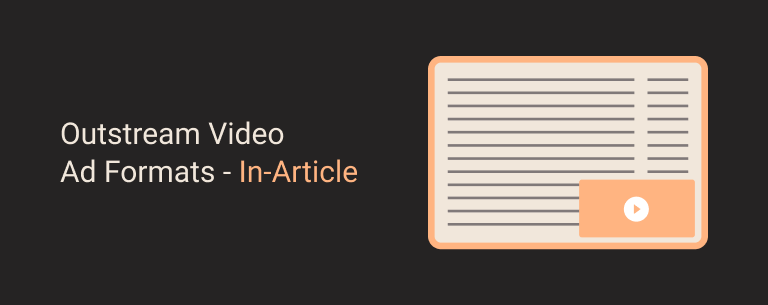
In-article video ads are inserted into the text content of a webpage. When you scroll to a certain point in an article, the video will start playing automatically, providing a non-intrusive user experience while still securing ad views.
- Strengths: High visibility without needing the user to engage in video content. Viewability averages 55%.
- Considerations: Needs to be balanced with content so as not to disrupt the reading experience.
Native Ads
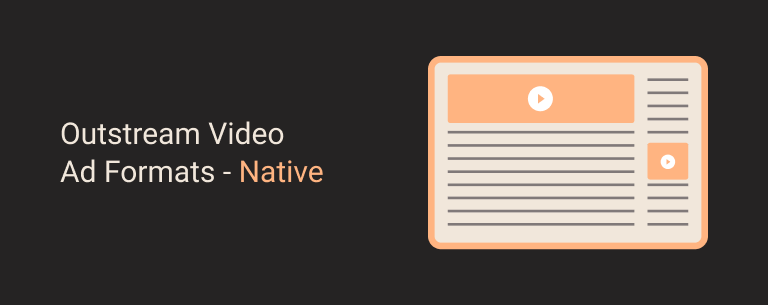
Native Ads integrate seamlessly with the platform, matching the look and feel of the content around them. This type of video ad is less disruptive and can drive higher engagement due to its organic appearance within your content.
- Strengths: Seamless integration reduces perceived ad intrusiveness.
- Considerations: Must maintain clear labeling as advertising to adhere to best practices.
In-Banner Video Ads
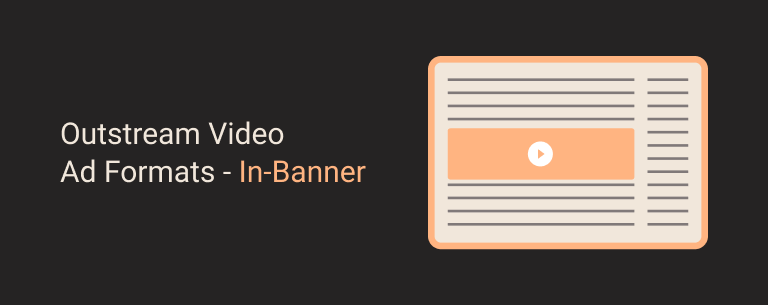
Finally, in-banner video ads are embedded within traditional display banners and are often played without sound. Even though they are less engaging than in-stream ads, they have the advantage of being placed in various strategic locations on the website.
- Strengths: Leverages existing ad spaces for video without requiring video content.
- Considerations: May have lower engagement compared to in-stream ads.
Pros
Cons:
{% icon icon_set="fontawesome-6.4.2" name="Plus" style="SOLID" height="20" purpose="decorative" title="Plus icon" %} Flexible placement options outside of the main video content stream.
{% icon icon_set="fontawesome-6.4.2" name="Minus" style="SOLID" height="20" purpose="decorative" title="Minus icon" %} Lower engagement rates and viewer attention compared to in-stream ads.
{% icon icon_set="fontawesome-6.4.2" name="Plus" style="SOLID" height="20" purpose="decorative" title="Plus icon" %} Not reliant on video content for ad deployment.
{% icon icon_set="fontawesome-6.4.2" name="Minus" style="SOLID" height="20" purpose="decorative" title="Minus icon" %} Requires careful integration to avoid hampering the user experience.
Through these diverse video ad products, your ad strategy can be effectively tailored to match your audience's preferences and your content's context, ultimately maximizing your monetization potential.
Video Monetization Methods
To maximize revenues, you can explore a variety of video monetization strategies. Each method has its own advantages and caters to different types of content and audiences.
Direct Deals
Direct deals allow you to negotiate terms with advertisers personally. This means you are in control of the ad pricing and the specific content where ads will be displayed. These types of agreements often result in higher revenue as middlemen are cut out, enabling you to set competitive rates directly with the advertisers interested in your audience.
Programmatic
Programmatic advertising uses algorithms to buy and sell ad inventory in real-time. By implementing a programmatic approach, you benefit from immense reach and advanced targeting options. Advertisers bid for your video ad spaces in what's known as an ad exchange, making the process efficient and often lucrative.
Hybrid
Hybrid selling combines programmatic demand with direct sold guaranteed deals using both sales methods synergistically to maximize revenue. Most publishers find this optimal.
Challenges of Video Monetization with Ads
While monetizing video with ads holds the potential for significant revenue, you'll face several challenges along the way that need careful navigation.
Scaling High-Quality Video
Creating high-quality video content consistently can be a daunting task, as it requires significant resources and investment. You need to balance the production costs without compromising the quality that attracts higher ad rates and engaged audiences.
Complying with IAB Instream Video Guidelines
To effectively monetize your video content with ads, you have to follow the Interactive Advertising Bureau's (IAB) instream video guidelines. This ensures that your ad delivery meets industry standards, which is critical for attracting premium advertisers and maintaining a positive user experience.
Keeping Users Engaged in the Video to Drive Mid-Roll
Ensuring that viewers stay engaged with your video content long enough to reach mid-roll ads is challenging. Your content not only has to be compelling, but the placement of mid-roll ads shouldn't disrupt the user experience. If viewers drop off early, potential ad revenue is lost.
How to get the most out of your video ads
Maximizing the potential of your video ads hinges on several key factors. Here's how you can optimize your video ad performance:
-
Understand Your Audience: Tailor your video ads to match the interests and behavior of your audience. Use data and analytics to refine your targeting.
-
Invest in Quality Content: Higher production values can lead to better engagement rates. Remember, your ad reflects your brand.
-
Choose the Right Ad Format: Different video ad formats, like pre-roll, mid-roll, and out-stream ads, offer unique advantages. Experiment to find what works best for your content and audience.
-
Placement and Timing: Ensure your ads appear in a contextually relevant environment and consider the timing within your video content for maximum impact.
-
Loading Speed: Optimize for fast loading to reduce bounce rates.
-
Monitor and Adjust: Keep an eye on metrics and be ready to tweak your strategy. Analytics tools can help identify areas for improvement.
By focusing on these areas, you can tap into the potential of video advertising to engage with your audience and monetize your digital content effectively. Remember, a strategic approach tailored to your specific audience will yield the best results.
Aeon helps publishers solve their video challenges
{% video_player "embed_player" overrideable=False, type='hsvideo2', hide_playlist=True, viral_sharing=False, embed_button=False, autoplay=False, hidden_controls=False, loop=False, muted=False, full_width=False, width='1920', height='1080', player_id='146552596876', style='' %}
Aeon's video production acceleration allows publishers unfamiliar with video techniques to condensed years of navigating capability gaps to months via automation. Both in-stream and outstream video ads become turnkey through bridging technical, strategic and operational challenges seen as adoption barriers.
Frequently Asked Questions
In this section, you'll find targeted answers to common questions about monetizing your digital content through video ads. These insights will help you better integrate ads into your videos, select the best networks for revenue, and enhance user experience without sacrificing monetization potential.
What strategies can digital publishers employ to integrate video ads effectively?
To integrate video ads effectively, digital publishers can create engaging, high-quality content that encourages audience retention, ensuring ads are seen. Utilizing in-stream video ad units that play before, during, or after your video can be a seamless way to include monetization without distorting content value.
Which video advertising networks offer the best CPMs for publishers?
The best CPMs for publishers often come from networks with strong demand partners and optimization algorithms. It’s important to find a network that aligns with your audience and content type. Exploring a header bidding partner like Snigel can help you capitalize on this to maximize your video ad revenue.
How can publishers choose the right video player that supports ad monetization?
Selecting a video player that supports ad monetization involves assessing compatibility with ad formats and standards (like VAST/VPAID), ease of use, and customizability. It's essential to ensure that the player provides a positive user experience and maximizes ad performance.
What are effective ways to optimize ad placement in video content for higher revenue?
Effective ad placement within video content includes positioning ads at natural breakpoints to minimize viewer disruption. Leveraging analytics to understand viewer engagement can guide the timing and frequency of ads to optimize revenue.
Can digital publishers monetize their video content without interrupting the user experience?
Yes, digital publishers can monetize their video content by using non-intrusive ad formats like overlay ads, sponsored cards, or picture-in-picture ads. These allow for monetization without taking away from the viewing experience. Additionally, choosing the right time to display ads plays a crucial role in maintaining a smooth user experience.
